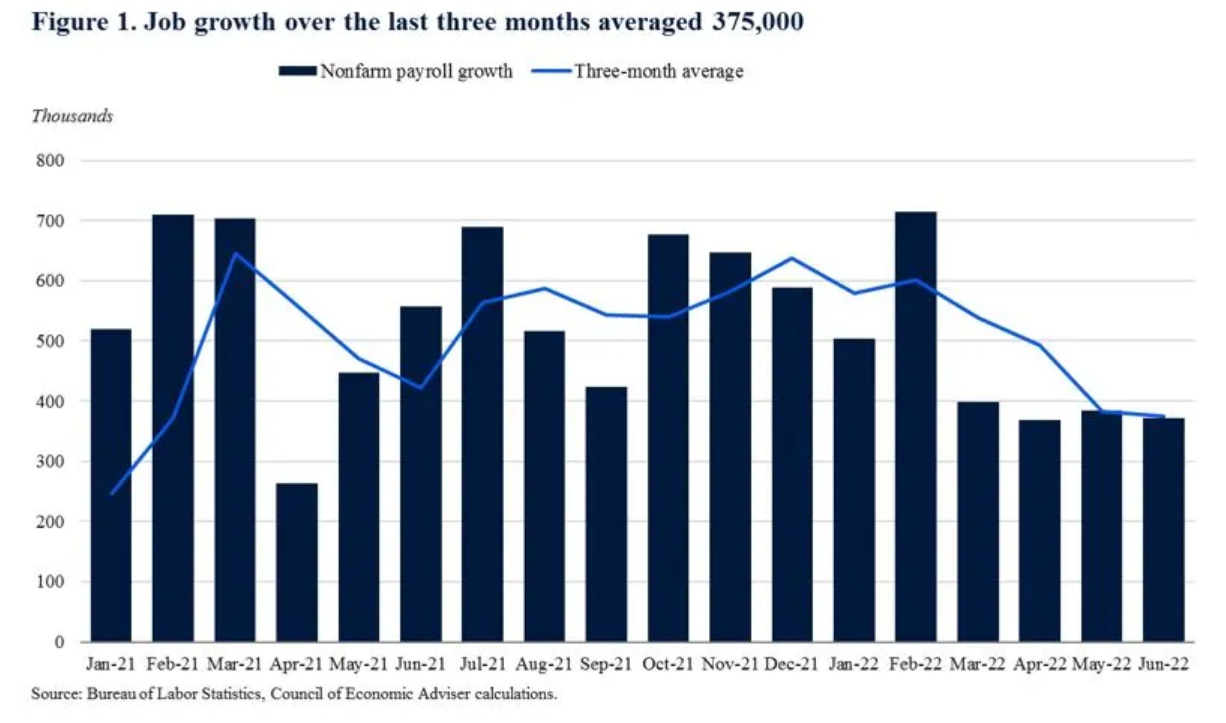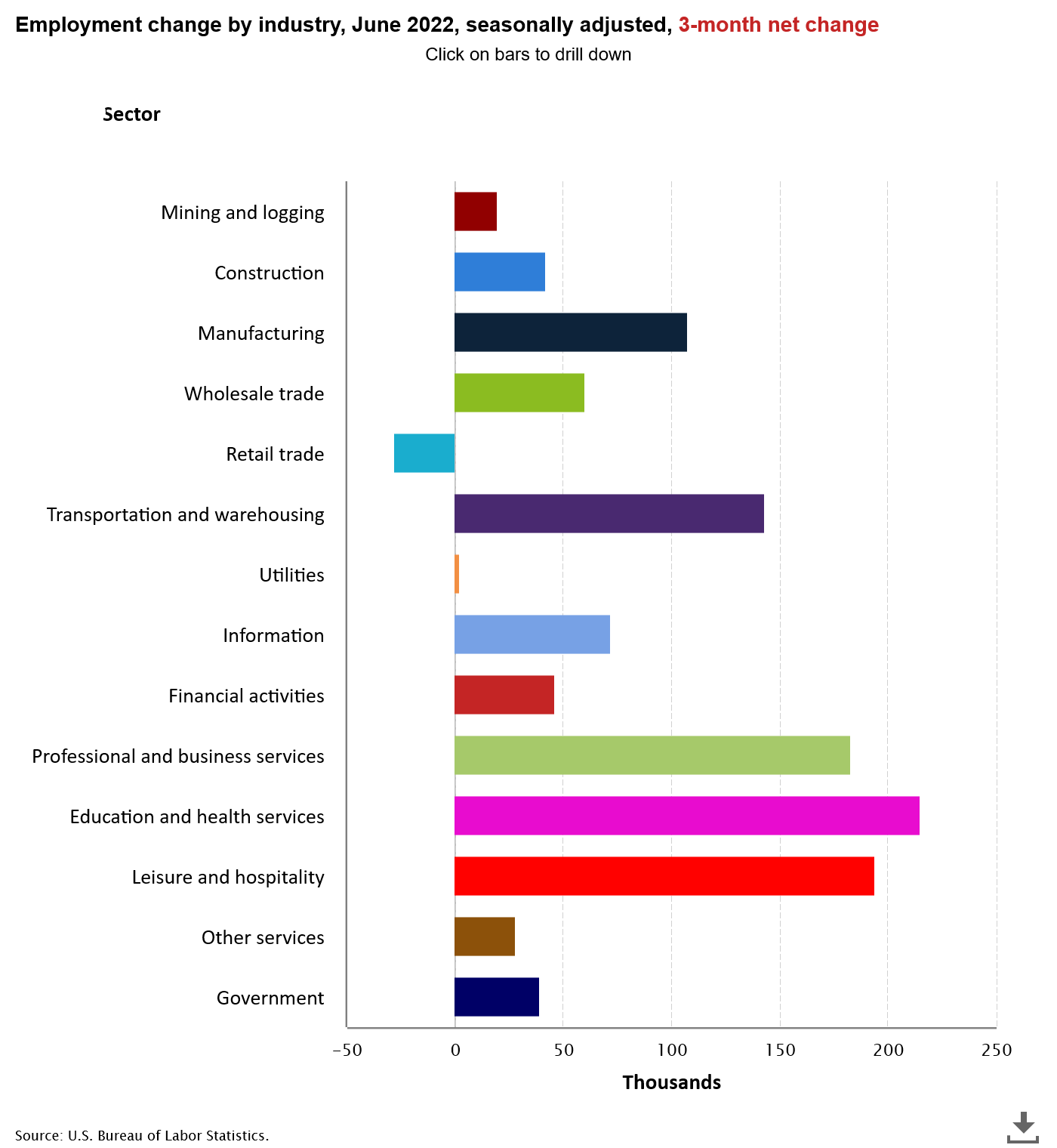U.S. Jobs Exceed Pre-Pandemic Levels as Strong Labor Market Continues to Grow
Q2 2022 Jobs Reports Analysis
Preliminary data shows that the United States has finally gained back the more than 20 million jobs lost since the beginning of the pandemic, as net job growth throughout 2021 and 2022 finally outpaced 2020’s net losses. Between the beginning of 2020 and June 2022, we have added approximately 191,000 more jobs than have been lost, according to the U.S. Bureau of Labor Statistics.
The economy still hasn’t fully recovered from the pandemic recession, but this labor market recovery was much more rapid than the sluggish recovery following the Great Recession. In July’s issue of the Economic Justice and Progress Newsletter, I’d like to discuss some of these details, why it was so important to avoid a repeat of our response to the last recession, and argue once again that this pivotal moment in U.S. history requires bold leadership.
First, let’s begin with a brief overview of the latest data.
April, May, and June 2022 Jobs Reports
Overall job growth has been fairly strong and relatively consistent since 2021. In my February newsletter, I noted how 2021 net job growth averaged more than 500,000 jobs added each month, and while growth has decelerated this year, it remains strong. The White House Council of Economic Advisors prepared the graph below showing monthly job growth and three-month averages since 2021.

The three-month average rate of job growth now sits at approximately 375,000 jobs per month. Just over a year ago, that three-month average was roughly 422,000, so our trend is moderating but growth remains strong. However, not all industries are recovering at the same rates.
Although overall employment levels are exceeding pre-pandemic levels, some industries have grown beyond pre-pandemic levels while others have yet to recover. Another CEA chart shows a breakdown of how various industries have fared since February 2020.

You’ll notice that the transportation and warehousing industry has nearly 15% more jobs than it had in February 2020, but others are still well below their pre-pandemic levels. We’ve discussed the leisure and hospitality industry throughout several articles, and while it often shows strong signs of growth in a given month, it also suffered a disproportionate amount of job losses throughout 2020.
According to the latest Job Openings and Labor Turnover Survey, it also has the highest rate of job openings. The accommodation and food services industry, in particular, has a 9.5% job opening rate representing approximately 1.4 million jobs.
But during the second quarter of 2022, every industry except retail trade grew, with some industries adding hundreds of thousands more jobs than they lost. The following BLS chart shows a visual breakdown of the preliminary data by industry.

For readers interested in the details, this table summarizing the BLS’s establishment data shows a monthly breakdown of the quarter, but I want to turn now to a comparison between the two most recent U.S. economic recessions.

Now that we’ve had time to see how the Pandemic Recession and the Great Recession panned out, I want to discuss policy decisions following each recession and their ensuing political ramifications.
A Tale of Two Economic Recoveries
A running theme throughout my newsletters has been to emphasize the importance of avoiding a repeat of the 2010 midterm elections. Not only do our elected officials need to better represent the people who voted them into office, but we also need to prevent an increasingly radicalized, anti-democratic movement from installing an authoritarian regime.

One of the first steps to avoiding such a takeover, in my view, involved bringing about a more economically just recovery following the most recent recession. While we still have a long way to go before achieving true economic justice, policymakers did learn from some, if not all, of their past mistakes.
Congress was wise to help working families early in the pandemic rather than only bailing out Wall Street while millions lost their jobs and homes across the United States like they did during the Great Recession. Widespread relief helped families weather the storm and kickstarted our economic recovery.
The graph below tracks employment in the years following both the Pandemic Recession and the Great Recession.

Twenty-eight months after the 2020 recession began, we have seen the shortest recession in U.S. history, and we are now back to pre-pandemic employment levels. By contrast, the Great Recession began in late 2007, persisted into 2009, and it took more than two years to even turn the corner on net job losses. The trajectories of the blue and red lines above, respectively, paint very different pictures of these two recessions.
The Political Need for Progress
Last year, I quoted an interview with Senator Bernie Sanders regarding the economic and political importance of avoiding the same mistakes made during the first years of the Obama administration:

Let me just be very clear: as the incoming Chairman of the Senate Budget Committee, I remember what happened in 2010. That is that Democrats, during the 2008-2010 period, controlled the White House, controlled the Senate, and controlled the House [of Representatives]. You remember that? And you remember what happened in 2010?
Democrats got wiped out [in the 2010 midterm elections]. They had the power, but they did not deliver for the American people.
So, what we have got to do right now—no ifs, buts, or maybes—is have an aggressive agenda that says: we understand that millions of people—including my neighbors right here in Vermont—people [are] lining up in their cars in order to get emergency food; people can’t pay their medical bills; people are going deeper and deeper into debt; people are facing eviction; millions of people have lost their jobs.
We have to act, and act now. And the first order of business, by the way, is to pass an emergency COVID-19 bill which, among many other things, says to working-class Americans: we know you’re in pain, and we’re going to get you a $2,000 check for every working-class adult in this country; we are on your side.
We are prepared to take on the big money interests who have so much power. We’re going to expand healthcare to cover the uninsured. We’re going to deal with student debt.
We have got to be bold in a way that we have not seen since FDR in the 1930s.
He’s right: they had the power, but they did not deliver for the American people.
The Biden administration learned some lessons from the mistakes of the Obama administration, but after passing the American Rescue Plan, the Democratic party has largely lost its political momentum to continue delivering for the people who voted them into office. As a result, Biden is now polling worse than President Obama ever polled, and is roughly on par with—and, according to some polls, even worse than—Trump’s approval ratings at the end of his reign.
The FiveThirtyEight poll tracker below shows Biden’s approval and disapproval rates throughout his presidency.
I wrote a long list of unfulfilled campaign promises and policies the Biden administration has yet to deliver, but the Biden administration is essentially signaling that they don’t want to do their jobs, and we’re wrong to even ask them to do their jobs. The White House Communications Director even had the audacity to say that “Biden’s goal… is not to satisfy some activists who have been consistently out of step with the mainstream of the Democratic Party” when discussing recent Supreme Court debacles.
Perhaps Biden should revert to his prior position that he would only serve one term if he’s not up to the task of being President of the United States. We can’t afford to lose another decade of progress while an illegitimate, radicalized Supreme Court dismantles any progress we made as a nation throughout the 20th century.
In the coming months, I plan to release a subscribers-only article looking more closely at the politics of this pivotal moment, discuss the ongoing assault on democracy, and advocate for meaningful solutions. Sign up for a paid subscription to have it sent to your inbox as soon as it’s published.
Until then, stay safe, take care of one another, and get organized.
Thank you for reading my newsletter and taking the effort to learn about making the world a better place. I look forward to hearing your thoughts on how we can make progress towards a more just economy.
-JJ




